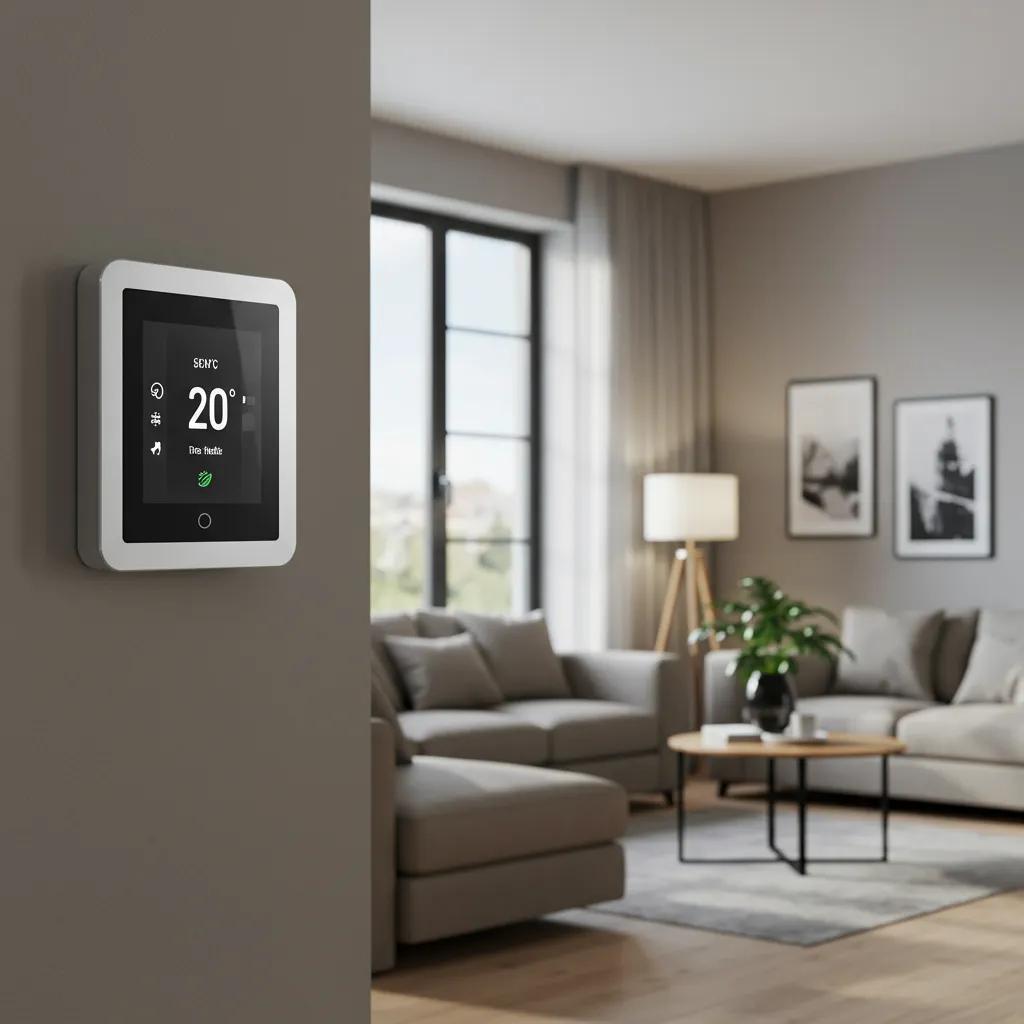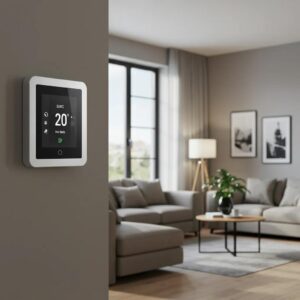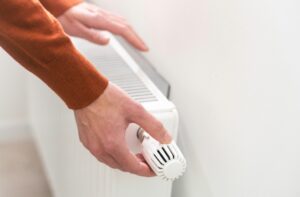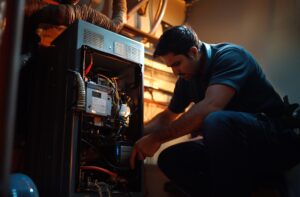Discover the Benefits of Smart Thermostats: Energy Savings, Comfort, and Control for Homes and Businesses
A smart thermostat is a Wi-Fi enabled device that learns your heating and cooling patterns to optimize energy use, reduce utility bills, and maintain consistent comfort. By analyzing occupancy, outdoor temperatures, and user behavior, it automatically adjusts settings to deliver up to 26 percent annual savings on heating and cooling. This article explores how smart thermostats drive energy efficiency, remote convenience, indoor comfort, commercial performance, professional installation, available incentives in 2025, and leading brand features. Throughout, All Around HVAC Construction’s expert installation and maintenance services are highlighted as the trusted solution for homeowners and small business owners seeking seamless integration and reliable support.
How Do Smart Thermostats Deliver Significant Energy and Cost Savings?
Smart thermostats reduce both energy consumption and monthly expenses by learning user habits and adapting schedules to actual occupancy and weather conditions. By replacing fixed schedules with dynamic adjustments, they minimize wasted heating or cooling when spaces are unoccupied. Integrating predictive algorithms and real-time sensor data, these devices cut heating costs by 10–12 percent and cooling costs by up to 15 percent for average households. Understanding these mechanisms reveals why they outperform manual and programmable thermostats.
The detection of occupancy in residential buildings has enabled the extraction of more representative occupancy schedules.
Smart Thermostats Employ Occupancy Sensors for Residential Energy Conservation
The smart thermostat utilizes these sensors to infer zone occupancy status. This data is then employed to adjust temperature setpoints within the zone for energy savings. For instance, when a zone is unoccupied, the smart thermostat can reduce the temperature to minimize energy consumption. Conversely, when a zone is occupied, the smart thermostat can elevate the temperature to ensure occupant comfort.
The smart thermostat: using occupancy sensors to save energy in homes, J Lu, 2010
When installed by All Around HVAC Construction, smart thermostats seamlessly integrate with existing HVAC systems, ensuring compatibility and maximizing savings potential. Expert technicians calibrate sensor thresholds, optimize placement, and verify wiring to enable advanced energy-saving features without disrupting daily routines. This professional approach secures consistent performance and long-term reliability.
What Energy-Saving Features Make Smart Thermostats Effective?
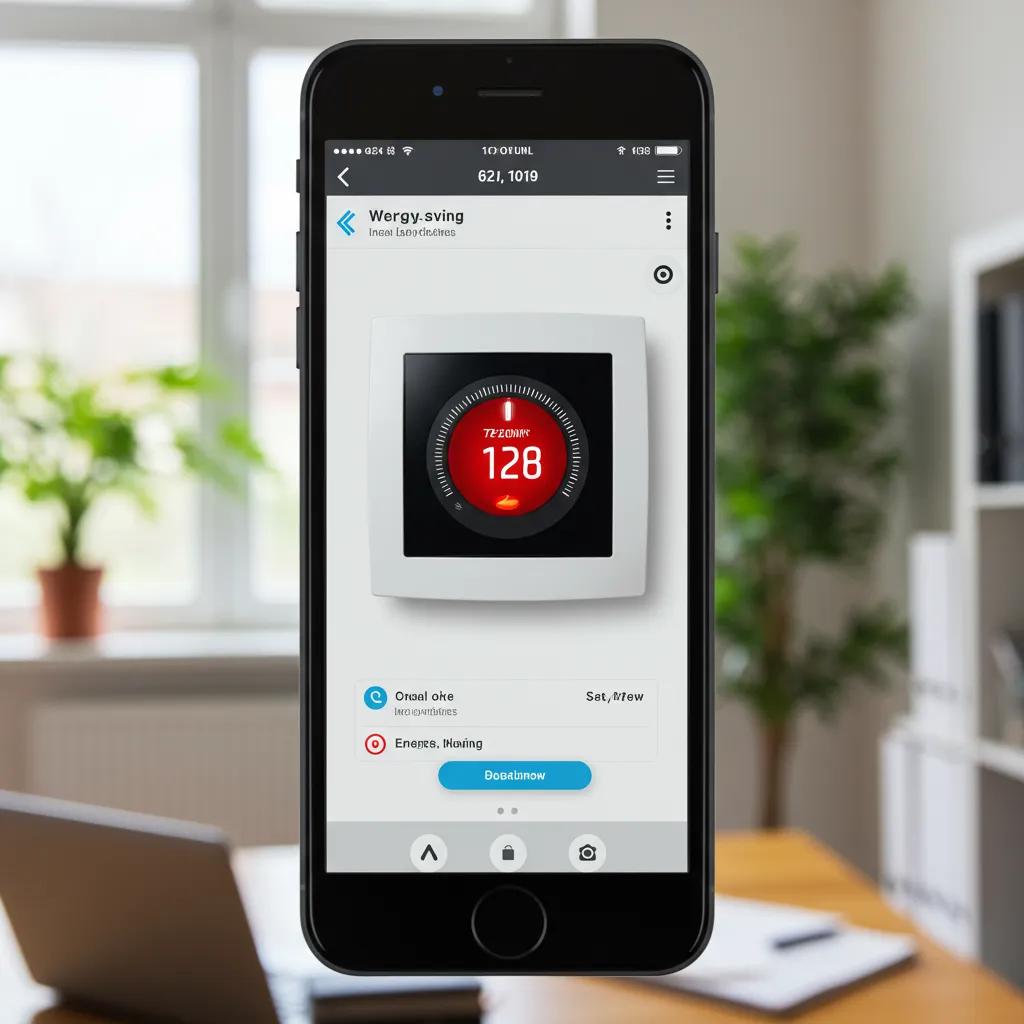
Smart thermostats use multiple features to drive energy efficiency:
- Learning Algorithms that adapt temperature settings based on daily routines and weather forecasts.
- Scheduling tools that adjust setpoints for nights and away periods automatically.
- Geofencing that triggers “away” mode when smartphone location indicates occupants have left.
- Occupancy Sensors that detect motion and fine-tune heating or cooling in used zones.
- Energy Usage Reports that visualize consumption patterns and guide efficiency improvements.
These capabilities combine to create a self-optimizing system that continuously refines comfort and savings, linking occupancy detection to temperature control seamlessly.
How Much Can Homeowners and Businesses Save on Utility Bills?
A smart thermostat can deliver average annual savings of:
| Setting | Home Savings (%) | Business Savings (%) |
|---|---|---|
| Learning Schedule | 8–12 | 10–15 |
| Geo-fencing | 5–8 | 7–10 |
| Occupancy Sensing | 6–9 | 8–12 |
| Combined Strategies | 15–26 | 12–18 |
These percentages translate into hundreds of dollars saved each year, depending on local energy rates and usage patterns. Businesses often see even greater operational reductions through centralized management of multiple units, driving down overhead and boosting profitability.
How Do Smart Thermostats Reduce Environmental Impact?
Smart thermostats reduce carbon footprints by optimizing HVAC cycles and minimizing peak demand energy use. Adaptive temperature control can lower household energy consumption by up to 30 percent, cutting greenhouse gas emissions significantly. When aggregated across communities, such efficiency improvements contribute to regional energy efficiency services and align with ENERGY STAR goals.
The analysis demonstrates that the temperature and occupancy-based control implemented by the smart thermostat yielded substantial energy savings when contrasted with conventional thermostat control.
Smart Thermostat Energy Savings and Comfort: A Residential Case Study
The analysis demonstrates that the temperature and occupancy-based control implemented by the smart thermostat yielded substantial energy savings when contrasted with conventional thermostat control. Furthermore, the study ascertained that the smart thermostat enhanced indoor environmental conditions through the maintenance of more stable temperatures.
Analysis of zone-by-zone indoor environmental conditions and electricity savings from the use of a smart thermostat: A residential case study, S Oh, 2020
Such eco-friendly performance underscores why local incentives prioritize smart thermostat adoption. By ensuring proper installation and calibration, All Around HVAC Construction helps customers maximize both financial and environmental returns.
How Do Smart Thermostats Compare to Traditional and Programmable Thermostats?
Traditional and programmable thermostats require manual adjustments or basic time-based schedules, lacking real-time responsiveness. In contrast:
| Feature | Traditional | Programmable | Smart Thermostat |
|---|---|---|---|
| Automatic Learning | No | No | Yes |
| Remote Access | No | Limited (Wi-Fi) | Full smartphone control |
| Occupancy Detection | No | No | Yes |
| Adaptive Scheduling | No | Pre-set only | Continuous self-optimization |
| Usage Reporting | No | No | Detailed energy analytics |
Smart thermostats outperform earlier models by automating adjustments based on context rather than relying on pre-set timetables. This leap in capability drives both cost and comfort improvements.
What Are the Remote Control and Convenience Benefits of Smart Thermostats?
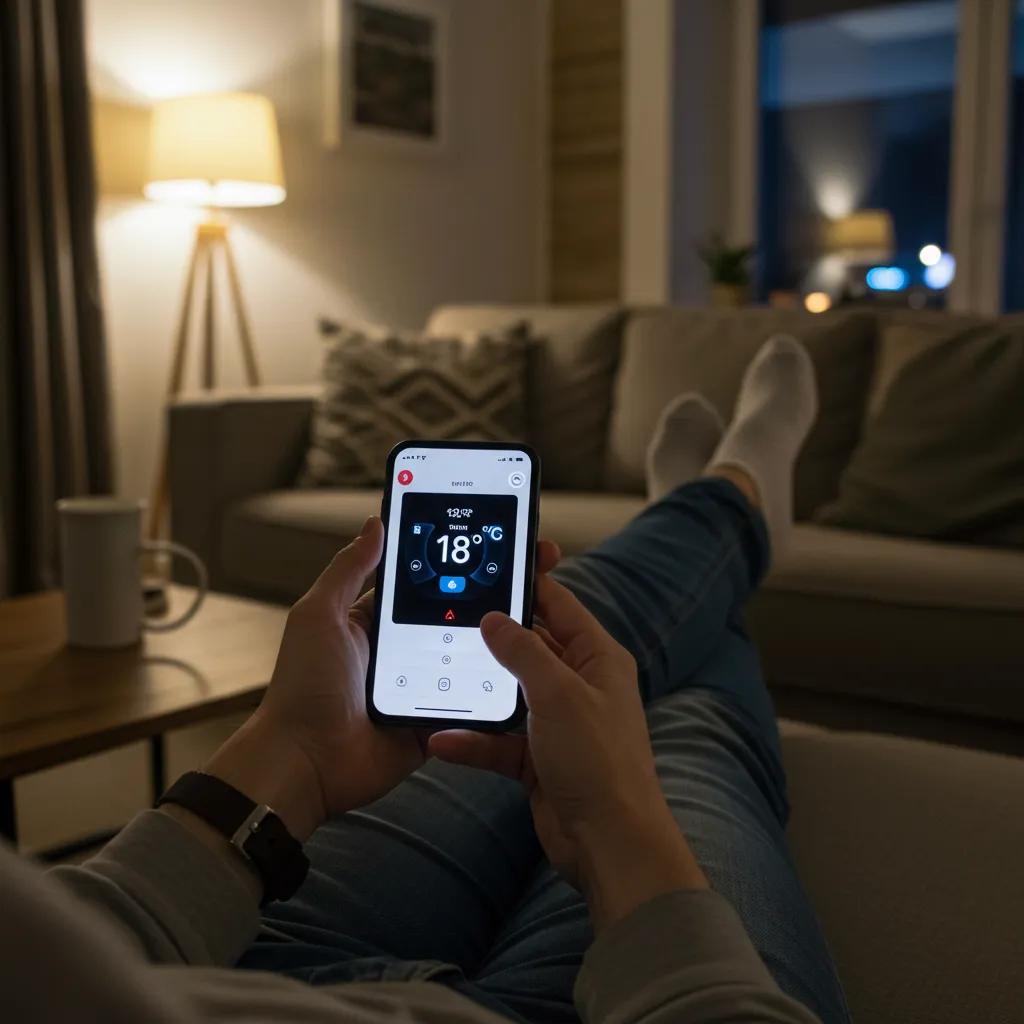
Smart thermostats enable remote management of temperature from anywhere, offering unparalleled convenience for busy homeowners and facility managers. Via dedicated smartphone apps, users can view real-time indoor conditions, modify schedules, and receive alerts about system performance. This seamless control fosters confidence that properties remain comfortable and efficient, even during vacation or business travel. Building on energy savings, remote connectivity forms the core convenience advantage of smart climate control.
Proper setup by All Around HVAC Construction ensures secure Wi-Fi integration, robust connectivity, and user-friendly app configuration. Technicians guide customers through account setup and permission controls, making remote features accessible with minimal effort.
How Does Remote Temperature Control Work via Smartphone Apps?
Remote temperature control leverages a secure cloud connection between the thermostat and a smartphone application. When a user adjusts the setpoint in the app, the command routes through encrypted servers to the thermostat, which then directs the HVAC system to change output. Real-time feedback confirms whether the adjustment has taken effect, offering immediate comfort management. This mechanism provides on-the-go adaptability and the reassurance that energy usage aligns with actual occupancy.
What Automation Features Enhance User Convenience?
- Voice Control integration with virtual assistants for hands-free adjustments.
- Smart Home Platform compatibility to synchronize HVAC settings with lighting and security systems.
- Custom Scenes that trigger multi-device routines (for example, “Away” mode dims lights and sets an eco-friendly temperature).
These automation layers create a unified living or working environment that responds intuitively to user needs and daily rhythms, reducing manual interventions and enhancing overall experience.
How Do Occupancy Sensors and Geo-fencing Improve Efficiency?
Occupancy sensors detect movement and inactivity to refine temperature control in real time, avoiding heating or cooling unoccupied zones. Geo-fencing uses smartphone location services to switch modes automatically when users enter or exit defined perimeters. Together, these technologies ensure energy is allocated only where and when it’s needed. This combination of spatial awareness and user location data drives substantial efficiency gains without sacrificing comfort.
How Do Smart Thermostats Improve Comfort and Indoor Air Quality?
Smart thermostats maintain consistent temperature standards by continuously evaluating environmental conditions and adjusting HVAC cycles accordingly. They compensate for external factors like sunlight, humidity fluctuations, and occupancy levels to prevent hot or cold spots. By prioritizing comfort through dynamic control, these devices create stable indoor climates that support productivity, well-being, and overall satisfaction. Understanding these comfort mechanisms lays the groundwork for exploring integrated air quality features.
How Do Smart Thermostats Maintain Consistent Home and Business Comfort?
Smart thermostats balance heating and cooling through adaptive heat-pump and compressor control cycles. They modulate HVAC runtime to avoid overshoot and rapid cycling, resulting in smoother temperature transitions. By learning building thermal inertia and integrating weather forecasts, they anticipate demand spikes and pre-condition spaces proactively. This advanced control reduces temperature swings and ensures uniform comfort throughout a facility or residence.
What Role Does Indoor Air Quality Monitoring Play?
Some smart thermostats integrate sensors for particulate matter, humidity, and volatile organic compounds. When air quality drops below set thresholds, they can trigger ventilation or adjust HVAC fan operation to introduce fresh air. This feature supports healthier indoor environments by reducing allergens, pollutants, and moisture levels. Automated alerts notify occupants when filter changes or maintenance are required, preserving system performance and air quality over time.
How Do Occupancy Sensors Detect Presence to Optimize Comfort?
Occupancy sensors use infrared or ultrasonic detection to sense motion in monitored areas. When presence is confirmed, the thermostat ensures immediate comfort by reverting to preferred temperature settings. Conversely, after extended inactivity, it shifts to an energy-saving mode. This intelligent presence awareness aligns climate control with actual use patterns and prevents discomfort from delayed manual adjustments.
What Are the Advantages of Smart Thermostats for Commercial Properties and Small Businesses?
Commercial smart thermostats offer centralized management of multiple zones, enabling facility managers to tailor temperature settings for specific work areas, conference rooms, and storage spaces. Advanced scheduling and load-shedding features facilitate demand response participation, lowering peak-hour energy charges. By unifying control under a single dashboard, businesses gain visibility into consumption trends, enabling data-driven decisions that reduce operational costs and enhance occupant productivity.
All Around HVAC Construction specializes in multi-unit installations for small businesses, configuring enterprise-grade thermostats and management software to deliver scalable performance and support.
How Do Commercial Smart Thermostats Enable Energy Management and Zone Control?
Commercial-grade smart thermostats connect to building automation systems, allowing separate temperature control in individual zones. They support granular scheduling, override permissions, and occupancy-based setback protocols tailored to each zone’s usage profile. Real-time dashboards display temperature, energy use, and system status for every zone, empowering managers to identify and address inefficiencies promptly.
What Cost Savings and Operational Benefits Do Businesses Experience?
Businesses typically realize:
- Reduced utility expenses by 12–18 percent through coordinated setpoint optimization.
- Lower maintenance costs via proactive alerts for system anomalies and filter changes.
- Improved occupant comfort that enhances focus and morale, leading to higher productivity.
These operational improvements provide a clear return on investment for smart thermostat deployments, making them a strategic component of energy management.
How Can Small Business Owners Benefit from Smart Thermostat Technology?
Small business owners gain scalable solutions that fit spaces of varying sizes—from retail shops to office suites. Cloud-based management ensures a single control point for multiple sites, simplifying oversight for remote owners. Flexible scheduling and remote adjustments prevent after-hours waste, while energy reports highlight cost-saving opportunities. This combination of features supports lean operational models and strengthens bottom-line performance.
Why Is Professional Smart Thermostat Installation and Maintenance Important?
Expert installation by certified HVAC professionals ensures correct wiring, optimal sensor placement, and seamless integration with existing ductwork and control systems. Proper setup prevents connectivity issues, erroneous temperature readings, and inefficient operation. Regular maintenance, including firmware updates and system diagnostics, keeps devices functioning at peak performance and protects customer investments over time.
All Around HVAC Construction’s technicians bring both HVAC and construction expertise, guaranteeing reliable installations and ongoing support for residential and commercial clients.
What Does Expert Installation by HVAC Professionals Involve?
Professional installation includes:
- System Compatibility Assessment to verify the thermostat matches HVAC equipment specifications.
- Precise Wiring and Configuration to connect sensors, power modules, and control relays accurately.
- Sensor Placement Optimization to ensure accurate ambient condition readings.
- Network and App Setup for secure remote access and user training.
This comprehensive process secures efficient system operation from day one and avoids common DIY pitfalls.
How Does Regular Maintenance Ensure Optimal Performance?
Routine maintenance includes firmware updates to enhance functionality, calibration checks to verify sensor accuracy, and diagnostic reviews of connectivity logs. Technicians also inspect wiring integrity, clean air filters, and test HVAC responses to thermostat commands. These proactive service steps prevent drift in performance, mitigate unexpected malfunctions, and preserve energy-saving capabilities over time.
What Are Common Smart Thermostat Issues and How Are They Resolved?
Common issues include connectivity dropouts, incorrect temperature readings, and app-sync failures. Resolution strategies involve rebooting network modules, recalibrating sensors on site, adjusting router settings for stable signal strength, and reinstalling application profiles. Professional troubleshooting ensures swift diagnosis and correction, minimizing downtime and maintaining comfort.
What Rebates and Incentives Are Available for Smart Thermostat Installation in 2025?
In 2025, most local utility providers offer rebates of $25 to $100 for installing an ENERGY STAR certified smart thermostat. Although there are typically no standalone federal HVAC tax credits for smart thermostats, customers can combine these rebates with broader energy-efficient HVAC upgrade incentives to achieve stacked savings. Understanding available programs maximizes financial benefits and shortens payback periods.
Which Local Utility Rebates Can Homeowners and Businesses Access?
Local electric and gas utilities often provide online applications for smart thermostat rebates. Eligible customers receive fixed-amount rebates—commonly $50 to $75—after submitting installation proof and device certification documentation. Some programs additionally offer tiered incentives for multi-unit commercial deployments, rewarding businesses for widespread adoption.
Are There Federal Tax Credits or Combined Incentives for Smart Thermostats?
While smart thermostats alone generally do not qualify for federal HVAC tax credits, they can be part of larger energy-efficient system upgrades that do. For example, replacing an entire heating or cooling system with ENERGY STAR certified equipment may unlock tax credits, and including a smart thermostat enhances overall efficiency and may increase total credit value.
How Can Customers Maximize Savings Through Incentive Programs?
- Confirm device ENERGY STAR certification before purchase.
- Bundle smart thermostat installation with other eligible HVAC improvements.
- File rebates and tax credit applications promptly with correct documentation.
- Consult All Around HVAC Construction for guidance on stacking local and federal programs.
This coordinated approach ensures the highest combined financial return on energy-efficient investments.
What Are the Key Features of Popular Smart Thermostat Brands Like Nest?
Leading smart thermostat brands differentiate through unique feature sets, user interfaces, and integration ecosystems. Understanding each brand’s strengths helps customers select devices that align with their comfort preferences, automation goals, and compatibility requirements.
What Unique Features Does the Nest Thermostat Offer?
The Nest Thermostat employs advanced learning algorithms that create personalized schedules within days of installation. It provides monthly energy reports that highlight savings opportunities and peak energy events. Integrated voice control via popular virtual assistants and sleek, minimalist hardware design enhance both functionality and aesthetics.
How Does Nest Compare to Other Leading Brands Like Ecobee and Honeywell?
| Brand | Learning Capability | Voice Control | Sensor Options | Platform Integration |
|---|---|---|---|---|
| Nest | Automatic schedule | Built-in | No external occupancy | Popular smart home systems |
| Ecobee | Adaptive schedule | Optional mic | Included room sensors | Comprehensive automation |
| Honeywell | Basic programming | Via bridge | Compatible accessories | Established HVAC platforms |
Ecobee’s room sensors offer granular comfort control, while Honeywell’s broad compatibility suits legacy systems. Each brand’s integration ecosystem influences user experience and long-term maintainability.
How Does Brand Choice Affect Installation and Maintenance?
Brand selection impacts wiring requirements, app configurations, and sensor compatibility. Some models need auxiliary power modules or C-wire adapters, while others rely on proprietary hubs. Maintenance considerations include firmware update frequency and cloud-service reliability. All Around HVAC Construction’s technicians assess brand-specific requirements in advance, ensuring smooth installations and straightforward future support.
Discover how integrating a smart thermostat can transform comfort, cut costs, and support sustainability in any home or business. By partnering with All Around HVAC Construction for professional installation and ongoing maintenance, customers unlock the full potential of intelligent climate control and maximize long-term savings.



